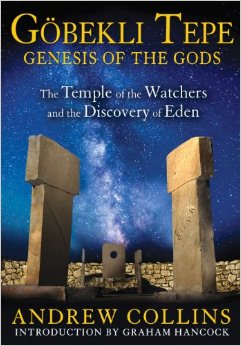


.
Gobekli Tepe, which is still being uncovered now. What I stated also was that the heretical Jewish work known as the book of Enoch, alluded to Eden, known also as “Paradise” and “Heaven”, as being the home of the Watchers, a race of mythical beings often identified as human-like angels.
They are credited with having revealed the forbidden arts and sciences of Heaven to mortal kind, causing mankind’s fall from divine grace, and his expulsion from the Garden of Eden.
.

The Story of the Watchers
In both the book of Genesis (chapter six) and the book of Enoch, the rebel Watchers are said also to have come upon the Daughters of Men, i.e. mortal women, who gave birth to giant offspring called Nephilim. For this transgression against the laws of Heaven, the renegades were incarcerated and punished by those Watchers who had remained loyal to Heaven. The rebel Watchers’ offspring, the Nephilim (a word meaning “those who fell), were either killed outright, or were afterwards destroyed in the flood of Noah. Some, however, the book of Numbers tells us, survived and went on to become the ancestors of giant races, such as the Anakim and Rapheim.
I wrote that the story of the Watchers is in fact the memory of a priestly or shamanic elite, a group of highly intelligent human individuals, that entered the Upper Euphrates region from another part of the ancient world sometime around the end of the last Ice Age, c. 11,000-10,000 BC. On their arrival in what became known as the land or kingdom of Eden (a term actually used in the Old Testament), they assumed control of the gradually emerging agrarian communities, who were tutored in a semi-rural life style centred around agriculture, metal working and the rearing of animal live stock. More disconcertingly, these people were made to venerate their superiors, i.e. the Watchers, as living gods, or immortals.
The precise same region of the Near East, now thought to be the biblical Garden of Eden, has long been held to be the cradle of civilization. Here a number of “firsts” occurred at the beginning of the Neolithic revolution, which began c. 10,000-9000 BC. It was in southeast Turkey, northern Syria and northern Iraq, for example, that the first domestication of wild grasses took place, the first fired pottery and baked statues were produced, the first copper and lead were smelted, the first stone buildings and standing stones were erected, the first beautification of the eyes took place among woman, the first drilled beads in ultra hard stone were produced, the first alcohol was brewed and distilled, etc., etc. In fact, many of the arts and sciences of Heaven that the Watchers are said to have revealed to mortal kind were all reported first in this region of the globe, known to archaeologists as Upper Mesopotamia, and to the people of the region as Kurdistan.
That the Watchers might have been behind the creation of Gobekli Tepe, now officially the “oldest temple in the world”, and the oldest known megalithic (i.e. great stone) complex anywhere, is almost beyond question, as is their role in the genesis of civilization. As to where their advanced knowledge and wisdom might have come from, the answer is, I suspect, otherworldly journeys using shamanic flight, something clearly indicated by the astral nature of the art found at these proto-Neolithic cult centres, which is predominantly avian in nature.
Yet in addition to reliefs and carvings of birds, including the vulture and ostrich, many other examples of reliefs and sculptures have been found at Gobekli Tepe. These show animals, insects, spiders, reptiles, hybrids and humans, which head excavator Dr. Klaus Schmidt from the DAI (German Archaeological Institute) sees in terms of the “watchman (sic) of the period”, a term he uses for those responsible for the construction of these strange, dark monuments of stone. The word “watchman” is so close to “Watcher” that this cannot be coincidence.
That Gobekli Tepe was constructed a full 7,000 years before either the Great Pyramid or Stonehenge is mind numbing in its implications for the history of human capability. More disturbing still is that the descendents of those Watchmen, or Watchers, who built Gobekli Tepe went on to construct further megalithic complexes. As these went on they became cruder and cruder, until the early Neolithic peoples of southeast Turkey were simply erecting uncut standing stones or slabs either in circles or in lines. Much of the finesse of Gobekli Tepe and its contemporaries (Karahan Tepe and Nevali Cori, for instance) was lost, tending to suggest that these people were losing the impetus to create more complex structures. Despite this, we can see here the foundation of the megalithic culture, who then spread, c. 7000-5000 BC, from Upper Mesopotamia carrying with them the technologies and sciences of the Neolithic age, including an understanding of plant domestication in order that the world could settle into a more sedentary life style, away from its previous course of constant hunter-gathering.

No comments:
Post a Comment